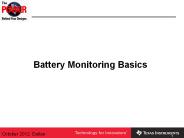C Basics - PowerPoint PPT Presentation
1 / 35
Title:
C Basics
Description:
C++ Basics C++ is a high-level, general purpose, object-oriented programming language. – PowerPoint PPT presentation
Number of Views:38
Avg rating:3.0/5.0
Title: C Basics
1
C Basics
C is a high-level, general purpose,
object-oriented programming language.
2
C Basics
- When executing a program the computer only does
what you have programmed , - no less, but also no more.
- If you forget anything, or the output does not
look pretty, or the results are incorrect,
there's nobody to blame - but yourself.
3
C Basics
- The computer understands (long) sequences of 0's
and 1's, humans only understand a natural
language such as English. - Therefore, there is a translation mechanism
involved when you try to tell the computer what
you want it to do
4
C Basics
TRANSLATION
Compiler
Object code
Source code
5
C Basics
- Source code The source code is a text document
that contains statements written according to the
rules - Object code A sequence of 0's and 1's that the
computer can, in principle, understand (machine
code). - A program called the compiler is used to
translate the source code into object code. - Executable code Sequence of 0's and 1's,
consisting of your object code plus any other
modules (machine code).
6
C Basics
TRANSLATION
Other files
Compiler
Linker
Object code
Source code
Executable code
7
C Basics
- When you write C programs,
- There are several things to keep in mind
- Your program does exactly and only what you
define, no more and no less - C programs execute, from top to bottom
- C programs can use cin to get input from a
user, and cout to display output - C programs usually do some computations
8
Basic C Rules
- every C program uses certain keywords that have
special meaning (e.g. int, main, void, return) - every C program uses certain operators that
perform specific actions (e.g. , , cin, cout) - every C program is case-sensitive,(e.g. int is
different from Int or INT) - every C program uses curly brackets to group
statements together - every C program has a semicolon at the end of
every instruction almost - every C program that handles user input and
output will contain the line include ltiostream.hgt
9
Basic C Rules
- almost every C program will contain the lines
.. int main(void) ..... - return 0
10
Declaring Variables
- C provides several different basic data types.
The most important ones are - double a decimal number
- int an integer number
- char a single letter or special symbol,
anything that is on your keyboard
11
Declaring Variables
- Example
- double x
- int X,y, z
- char d
- C is case-sensitive
- Variable names can not contain spaces. They must
start with letters, and can contain only letters,
numbers, and certain special symbols such as an
"underscore" _.
varName
type
12
Assigning values to variables
- Once a variable is declared, you can assign
values to it. - varName expression
- Example
- double x
- x 10.0
expression
varName
Note that this operation looks like the math
symbol for equal, but it works differently
13
Assigning values to variables
- When you assign an expression to a variable, the
following happens - first,
- the value of the right side is computed
- second,
- that computed value is assigned to the variable
on the left
14
Assigning values to variables
- Example
- double x, y
- int i, k
- x 2.8
- y -1.4x
- i 9
- k (i 2) (7 5i)
the value of the right side is computed
computed value is assigned to the variable on the
left
15
Assigning values to variables
- Combined Declaration and Assignment
- In C, you can declare a new variable, and at
the same time assign a value to it (or initialize
the variable) - Example
- double x 1.0
- int i 10, j 20
- int k i j
16
Defining Constants
- To define a constant in C you preface the type
of the variable by the keyword const. - Example
- const double pi 3.1415
17
Defining Constants
- A constant
- can not change inside your program.
- usually declared at the beginning of your
program, - must be assigned a value at the time you declare
them.
18
- Now we can produce some more interesting programs.
19
A sample program
- Task 1 Create a program that asks the user for
the radius of a disk, then computes the area and
circumference.
20
A sample program
- Stage 0 As usual, our stage-0 program is
- include ltiostream.hgt
- int main()
- ......
- return 0
21
A sample program
- Stage 1 We use comments to break up our task
into smaller subtasks - include ltiostream.hgt
- void main()
- // get the radius from the user
- // compute the area
- // compute the circumference
- // display the answers
22
A sample program
- Stage 2 Now we get into the details of which
variables and formulas to use - include ltiostream.hgt
- int main()
- const double pi 3.1415
- // need a variable r for the radius
- double r
- // getting the input from the user
- cin gtgt r
- // computing the area A pi r2
- double A pi r2
- // computing the circumference
- double C 2 pi r
- // displaying both answers
- cout ltlt A
- cout ltlt C
- return 0
23
A sample program
- Stage 2 Now we get into the details of which
variables and formulas to use - include ltiostream.hgt
- int main()
- const double pi 3.1415
- double r,A,C
- cin gtgt r
- A pi r2
- C 2 pi r
- cout ltlt A
- cout ltlt C
- return 0
24
A sample program
- At this point, we let the compiler tell us if the
C grammar is correct or not. - The compiler will tell us the r2 is "unknown",
so we change that line to - A pi rr
25
A sample program
- Then we compile it again. It will now compile
- So we can link it to produce the executable file.
- Finally, we execute the program to test it, and
we find that everything works, but it does not
look good. - So, we'll modify the program inputoutput one
more time.
26
A sample program
- Stage 3 We add some more input/output statements
to make our program more "appealing" to the user
- include ltiostream.hgt
- int main()
- const double pi 3.1415
- double r,A,C
- cout ltlt "Please enter the radius "
- cin gtgt r
- A pi rr
- C 2 pi r
- cout ltlt "The area is "
- cout ltlt A
- cout ltlt "The circumference is "
- cout ltlt C
- return 0
27
A sample program
- Acutally, the last four statements can be linked
together. Instead of saying - cout ltlt "The area is "
- cout ltlt A
- cout ltlt "The circumference is "
- cout ltlt C
- we can also say
- cout ltlt "The area is " ltlt A ltlt " and the
circumference is " ltlt C
28
A sample program
- After changing that, our program will work
correctly, and produce reasonably nice looking
results on the screen. - include ltiostream.hgt
- int main()
- const double pi 3.1415
- double r,A,C
- cout ltlt "Please enter the radius "
- cin gtgt r
- A pi rr
- C 2 pi r
- cout ltlt "The area is " ltlt A ltlt "The
circumference is " ltlt C - return 0
29
Software Development
- When creating a program, you usually proceed in
four distinct stages - Problem Analysis
- Design
- Coding
- Verification and Validation
30
Stage 1 Problem Analysis
- In this stage you analyze what exactly it is that
your program needs - In particular, you describe
- all input values,
- i.e. values that must be supplied from outside
the program - all constant values,
- i.e. values that are given with the problem
- all output values,
- i.e. values that must be produced as part of the
solution to the problem - You should also think about the types of all
these values.
31
Stage 2 Design
- In this stage,
- break up the problem into subtasks in the order
- write the pseudocode, using comments to describe
the subtasks instead of actually coding it. - All necessary formulas are part of this stage.
32
Stage 3 Coding
- In this stage
- enter the code for your program, following the
rules that C requires. - leave the comments from stage 2, and put your
code after the respective comments. - The end product of this stage should be a program
that compiles and links without errors.
33
Stage 4 Verification and Validation
- Check if your program works correctly,
- Is the sequence of events correct ?
- Does your program print out enough information to
guide the user as to what to do and what the
output means ?
34
1.Problem
- Create a program that will compute the volume of
a sphere, given its radius.
35
2.Problem
- You are working as a consultant for a cable
company. For each installation that is performed
by the company, there's a 25.00 service charge
and an additional 2.00 charge per meter of cable
used. - They need a program to compute the total income
per month. - In other words, if they use 263 meter of cable
at 27 different locations, they make 1201.00
income.































